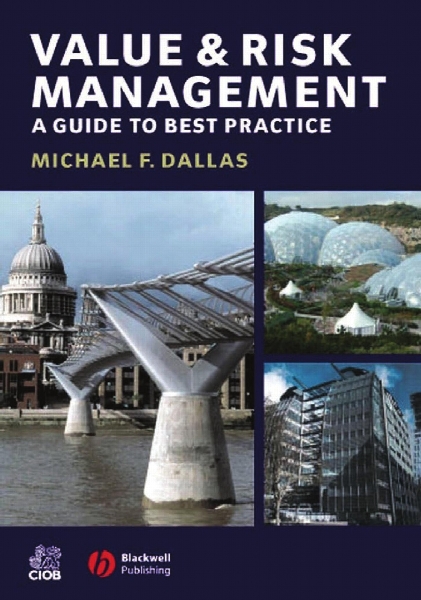Value and risk management : a guide to best practice
- نوع فایل : کتاب
- زبان : انگلیسی
- مؤلف : Michael Dallas
- ناشر : Oxford ; Malden, MA : Blackwell Pub.,
- چاپ و سال / کشور: 2006
- شابک / ISBN : 9781405120692.
Description
Key Features and Benefits -- 1.0 Why Successful Projects need Value and Risk Management -- 1.1 Delivering Success -- 1.2 Alignment With Construction Industry Improvement Initiatives -- 1.3 Summary -- Principles of Value Management -- Summary -- 2.0 Essential Attributes -- 2.1 A Brief History -- 2.2 Language -- 2.3 Concepts -- 2.4 The Family -- 2.5 Value Management Through The Project Cycle -- 2.6 The Generic Process -- 2.7 Value Or Cost? Balancing Benefits With Investment -- 2.8 The Value of Time -- 2.9 Quality -- 2.10 Measuring Value -- Principles of Risk Management -- Summary -- 3.0 Essential Attributes -- 3.1 Evolution -- 3.2 Language -- 3.3 Concepts -- 3.4 The Family -- 3.5 The Risk Management Cycle -- 3.6 The Generic Process -- 3.7 Risk To Quality -- 3.8 Measuring Risk -- 3.9 Contingency Management -- 3.10 Time Risk -- Integrating Value And Risk Management -- Summary -- 4.0 Why Integrate. 4.1 The Integrated Process -- 4.2 Timing -- 4.3 Project Stages and Study Types -- 4.4 Understanding The Client Business -- 4.6 Project Launch Studies -- 4.5 Programmes Of Projects -- 4.7 Summary Of Value And Risk Study Types -- 4.8 Critical Success Factors -- 4.9 A Framework For Introducing Value And Risk Management into an Organisation -- 4.10 Embedding Value and Risk Management into an organisation -- 4.11 Drawing on experience -- 4.12 Selecting the appropriate level of activity -- 4.10 Planning Value And Risk Management Programmes -- The People And Their Roles -- Summary -- 5.0 The People And Their Roles -- 5.1 Confrontation Versus Collaboration -- 5.2 Stakeholder Analysis and Management -- 5.3 Team Building -- 5.4 Partnering -- 5.5 Communications -- 5.6 The Supply Chain -- 5.7 Selecting the Study Team -- 5.8 The Study Leader -- 5.9 Styles Of Leadership -- 5.10 A Study Structure Based Upon Logic -- 5.11 Overcoming Difficulties -- 5.12 Using Conflict To Advantage -- 5.13 Gaining Consensus -- 5.14 Developing Value And Risk Culture -- 5.15 Language -- Concepts, Standards and Qualifications -- Summary -- 6.0 Understanding Value and Risk. 6.1 Understanding Value -- 6.1.1 Concepts of Value -- 6.1.2 Articulating and assessing Value -- 6.1.3 Value Management Standards -- 6.2 Understanding Risk -- 6.2.1 Concepts of Risk -- 6.2.2 Articulation and Assessment of Risk -- 6.2.3 Risk Management Standards -- 6.3 Training and Certification Systems -- Learning from others Summary -- 7.0 Practice In Other Sectors -- 7.1 A Value And Risk Management Approach To Project Development -- 7.2 Soft Value Management -- 7.3 Value Management In Manufacturing -- 7.4 Value Management For Public Services -- 7.5 Risk And Enterprise -- 7.6 The Impact Of Partnering On Value And Risk -- 7.7 Just how mature are your organisations processes? -- Study Types -- Summary -- 8.0 Types Of Study -- 8.1 Value Management Studies -- 8.1.1 Need Verification -- 8.1.2 Project Definition -- 8.1.2.1 Stakeholder conferencing -- 8.1.2.2 conventional workshop -- 8.1.3 Brief Development -- 8.1.4 Value Engineering -- 8.1.5 Design And Cost Review -- 8.2 Risk Management Studies -- 8.2.1 Strategic Risk Study -- 8.2.2 Initial Project Risk Study -- 8.2.3 Risk Reviews -- 8.2.3.1 Formal Reviews -- 8.2.3.2 Informal Reviews -- 8.2.3.3 Operational Reviews: Business Continuity -- 8.3 Combining Risk And Value Reviews -- 8.4 Project Reviews -- 8.5 European Practice -- 8.6 The Project Cycle -- 8.7 Building On Experience -- Techniques For Value And Risk -- Summary -- 9.0 The need for techniques. 9.1 Preparation Before A Study -- 9.1.1 The Strategic Briefing Meeting -- 9.1.2 Preparation Workshop -- 9.1.3 Pre-Study Training -- 9.2 Invitation To Participate -- 9.3 The Workshop -- 9.4 Recording -- 9.5 The Wrap-Up Meeting -- 9.6 Reporting -- 9.7 Reviewing Progress -- 9.8 Whole Life Costing -- 9.9 Stakeholder Analysis -- 9.10 Partnering -- 9.11 Mind Mapping -- Value Management Techniques -- Summary -- 10.0 Value Management Techniques -- 10.1 Function Analysis -- 10.2 Function Analysis System Technique (FAST) -- 10.3 Cost/Worth -- 10.4 Multifunctional Components -- 10.5 Simple Multi-Attribute Rating Technique -- 10.6 Value Drivers -- 10.7 Value Profiling (Or Benchmarking) -- 10.8 Option Selection -- 10.9 Weighting Techniques -- 10.10 Generating Ideas For Adding Value (Creative) -- 10.11 Selecting The Best Ideas (Evaluation) -- 10.12 Developing Implementation Proposals -- 10.13 Scenarios -- 10.14 Target Costing -- 10.15 Function Performance Specification -- Risk Management Techniques -- Summary -- 11.0 Risk Management Techniques. 11.1 Risk Analysis and Management -- 11.2 Identifying Risks -- 11.3 Assessing Risks -- 11.3.1 Qualitative Assessment -- 11.3.2 Quantifying Risks -- 11.4 Managing Risks -- 11.5 Optimism Bias -- 11.6 Construction (Design and Management) (CDM) Regulations -- 11.7 Risk breakdown structures -- 11.8 Failure modes and effects analysis (FMEA) -- 11.9 Hazard and operational studies (HAZOP) -- Toolbox, Checklists, Forms And Tables -- Summary -- 12.0 Toolbox -- 12.1 Briefing Checklist -- 12.2 Information Checklist -- 12.3 Study Toolkit -- 12.4 Workshop Invitation -- 12.5 Recording Information Generated During Workshop -- 12.6 Reports -- 12.7 Value Management Categories/Prompt List -- 12.8 Risk Identification Prompt List -- 12.9 Value Profiling Proforma -- 12.10 Option Evaluation Matrix -- 12.11 Weighting Tool -- 12.12 Paired Comparison Proforma -- 12.13 Proforma For Whole Life Cost Estimating -- 12.14 Scenario Building Form -- 12.15 Whole Life Cost Checklist -- 12.16 HAZOP Analysis Sheet -- 12.17 Room Layouts -- Appendix A References -- Appendix B Glossary -- Index.
Published on behalf of the Chartered Institute of Building and endorsed by a range of construction industry institutes, this book explains the underlying concepts of value and risk, and how they relate to one another.


